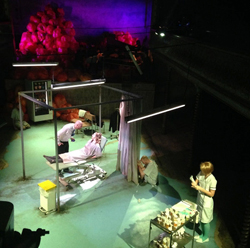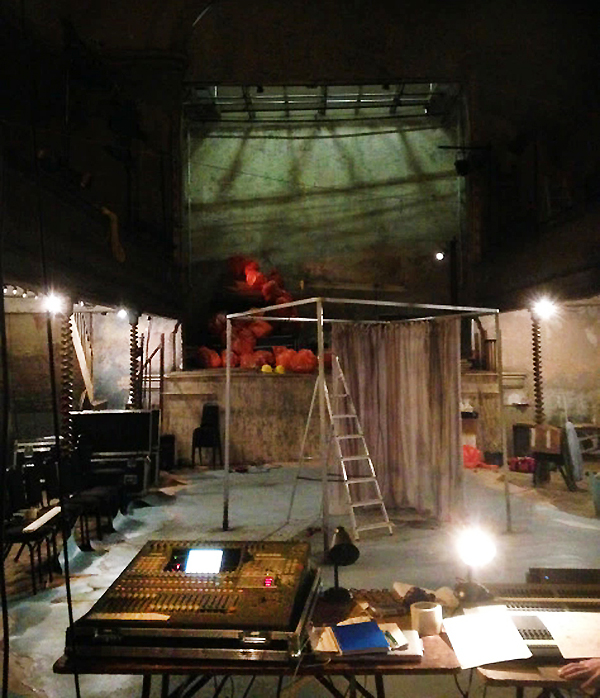
Rehearsals
Given the musicians would be elevated and behind the singers, I initially thought I would need to close mic the quieter string instruments (lute and guitar) to make them heard above the singers and the harpsichords.
When budget constraints prevented this, I trusted that the timbre of the instruments would make them easily audible in the mix of sound, and thankfully, I was proved right. In fact, miking the lute and guitar would have added nothing to the performance. Proving that sometimes the easiest solution is the best one!
With the venue assessed and the ensemble requirements scoped, my next task was to introduce the pre-recorded elements of the sound design and decide on speaker placement.
The Details
The bulk of my design centered around the opening of the show. My brief was to create an ambient hospital soundscape which built to a climax as the singers entered, changing to a gentler version of the same soundscape which played under the first unaccompanied madrigal. This then cross-faded into a pre-recorded prologue of the Health Minister addressing modern-day parliament, with raucous “hear hears” merging into the opening chords of the opera.
Using the beautifully squalid set and stark lighting as inspiration, I built the pre-show soundscape around layers of ominous drones, electric hums and affected hospital sounds of ventilators, surgery and heartbeats. The world of the opera was virtually extended to suggest the hospital outside of the physical space, footsteps echoed in distant corridors, light bulbs flickered and snatched pre-recorded bars of madrigals were heard briefly from individual speakers, cut off by door slams.
Gauging levels for pre-show ambience is tricky. Too high and it becomes intimidating (unless that’s the effect you want), too low and it risks being drowned out by the audience chatter. I don’t feel I ever got the levels quite right, but the intimidating atmosphere of the hazy lighting state and “aggressively unlovely design” (The Arts Desk) helped. Having a show that looked and sounded like an apocalyptic asylum overrun by zombies did, at least, keep the sound of the pre-show audience down to a subdued murmur.
Knowing that the heavy drones of the pre-show soundscape would muddy the purity of the first unaccompanied madrigal, I stripped back the layers to leave the gentle sound of dripping water and a very low-level electrical hum to continue the suggestion of a run-down institutional space.
We solved the problem of how the first singer pitched the initial note by putting a pitched tone into the speaker nearest his entrance point. At the right level, amongst the other interwoven drones and sounds, another note was imperceptible to the audience and audible enough for the singer to pitch his first note.
Loudspeaker Placement
An immersive soundscape deserves an immersive physical design, or as immersive a design as I could create given the budget. I arranged the seven loudspeakers I had at my disposal accordingly. I placed four surrounds in the stalls (two RCF compact models fed from a Yamaha P7000S amplifier, plus two active Yamaha MSR400 loudspeakers).
Two more loudspeakers covered the balcony (Eurolive E1220s fed from a Yamaha P3500S amp), and there was one sub (RCF S8018). My final loudspeaker (another Yamaha MSR400) positioned behind a working vending machine to provide a steady vending machine-type hum.
Like many historical venues run by an independent charity, Wilton’s relies on donated equipment and like many independently-funded productions, the budget for sound was limited. Aside from a new audio interface, I worked with what the venue could supply. The desk was a Yamaha O2R digital mixer, which I hadn’t used since the early 2000s and never outside of a studio, but at the end the day, signal flow is signal flow and it was nothing a few cables and logical patching couldn’t fix.

